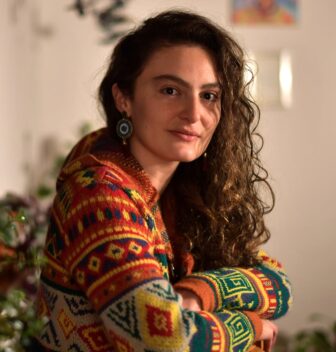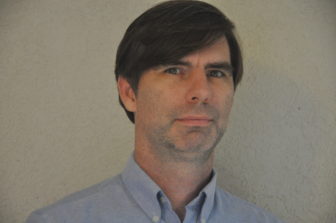Biofuel. Bricks. Paper. Beauty products. A carbon capture system.
Many Caribbean entrepreneurs see an unprecedented economic opportunity in the sargassum that has regularly swamped the region since 2011.
But despite their enthusiastic pitches — and widespread consensus that the only realistic solution to the crisis is monetizing the seaweed — no consistent large-scale use for it has been found.
“Even though there are so many things you can make with sargassum, the actual amount of sargassum that is used for products is still very low,” said Dr. Franziska Elmer, a Mexico-based scientific project manager for the United Kingdom-headquartered carbon solutions company Seafields.
As a result, sargassum is usually handled as waste, with annual costs for clean-up and disposal estimated by researchers in the region to be as high as $210 million in the Caribbean.
Companies like Seafields hope to change that. In recent years, entrepreneurs and researchers have doggedly sought the secret to turning sargassum into “brown gold”, as professor Mona Webber, from the Mona Campus of the University of the West Indies in Jamaica, likes to call the seaweed.
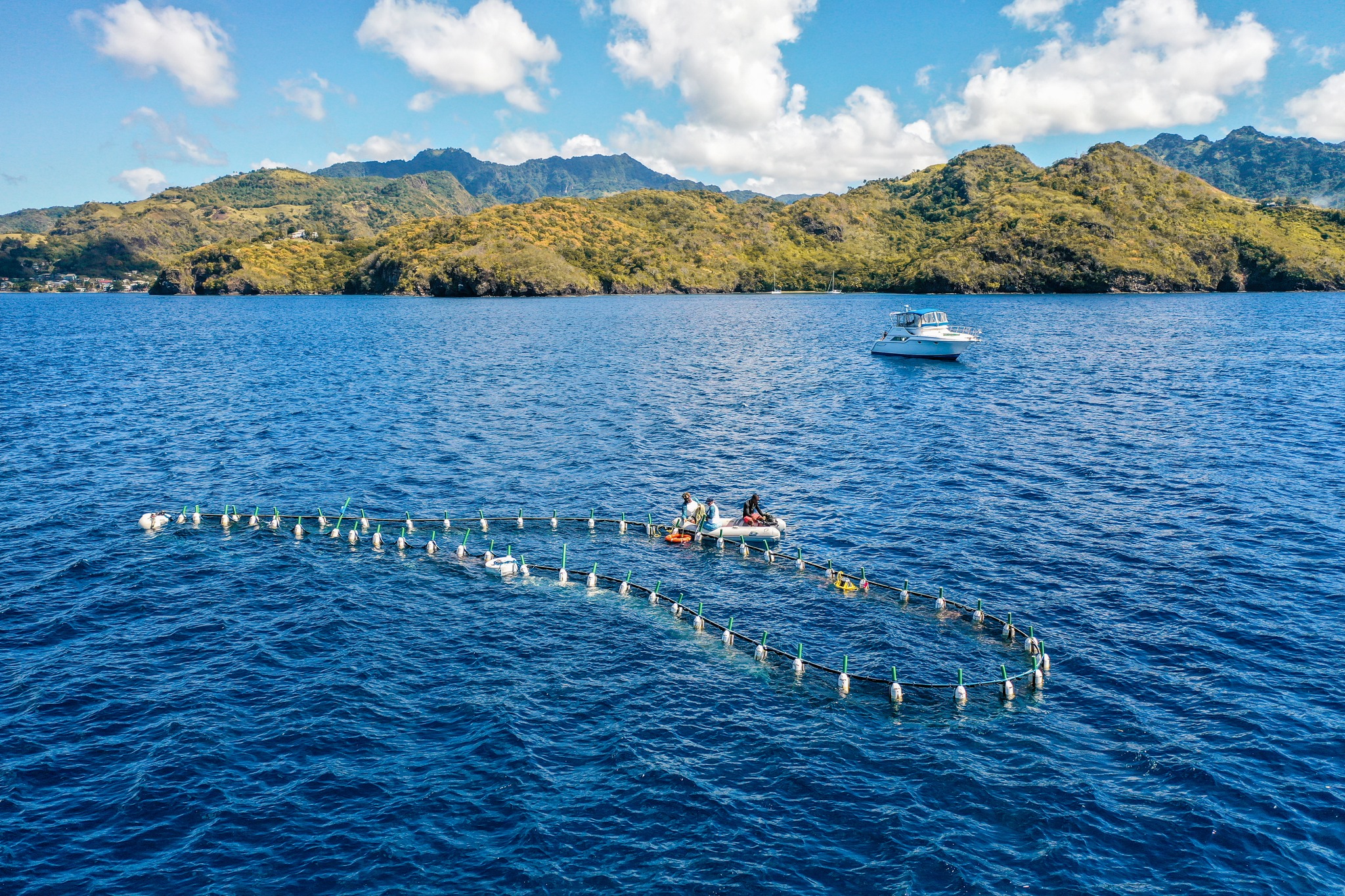
The United Kingdom-based company Seafields is working to build aquatic farms that store sargassum in enclosed paddocks like the one shown above in St. Vincent and the Grenadines last year.
Photo courtesy of Seafields
But daunting challenges remain to finding a profitable business that will make a sizable dent in the millions of tons of sargassum that wash up on the region’s shorelines each year. Entrepreneurs who spoke to the Puerto Rico Centro de Periodismo Investigativo described operating in a largely unregulated environment where information is patchy and funding is hard to find.
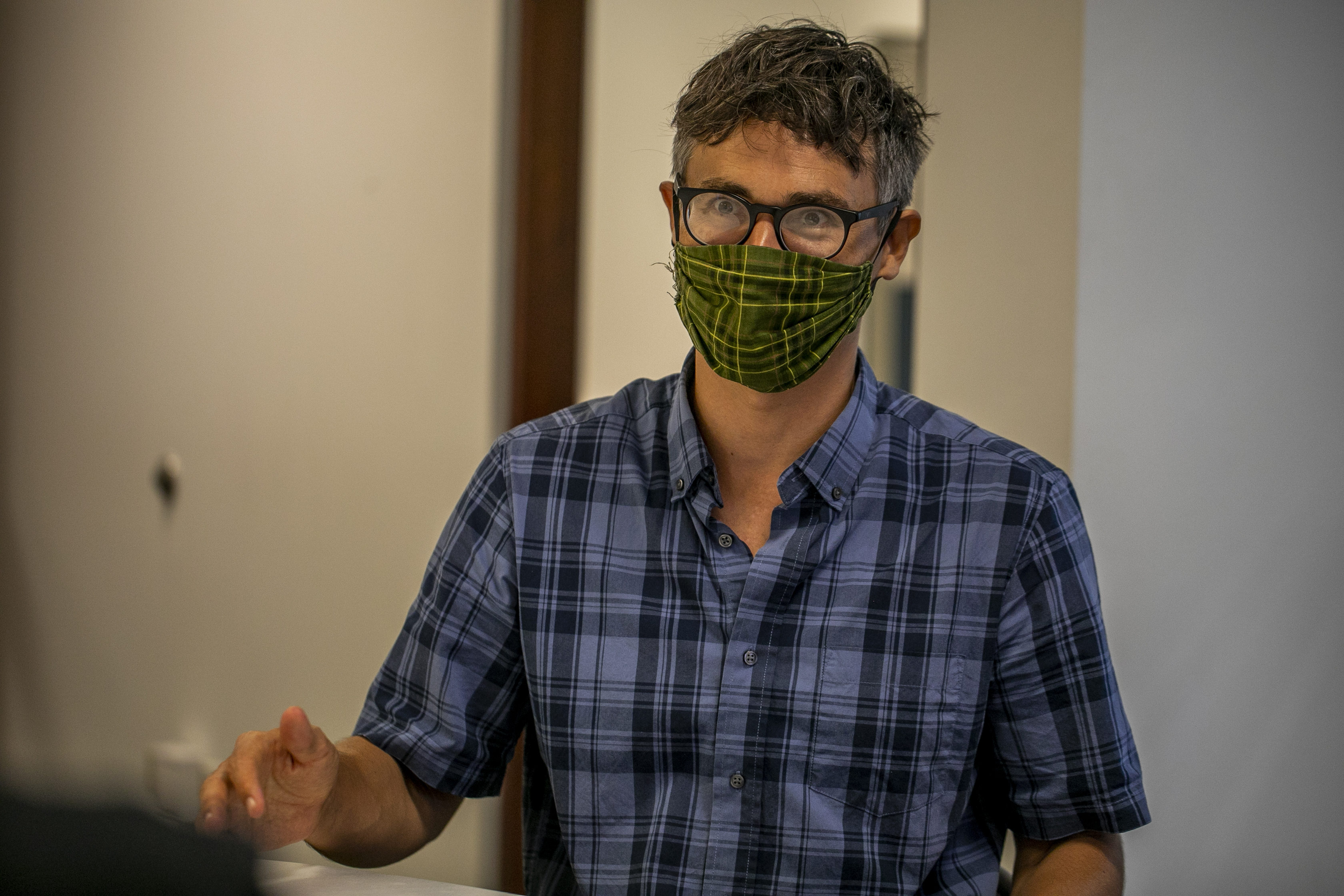
Benjamin Jelen is a Research and Development Director at C-Combinator located in Cataño, Puerto Rico, where they study the potential use of sargassum-derived products.
Photo by Xavier García | Centro de Periodismo Investigativo
“Most of the regulations are focused on managing the pickup, and there’s not much regulations on products. And that makes it difficult to make products,” said Elmer, the Seafields researcher.
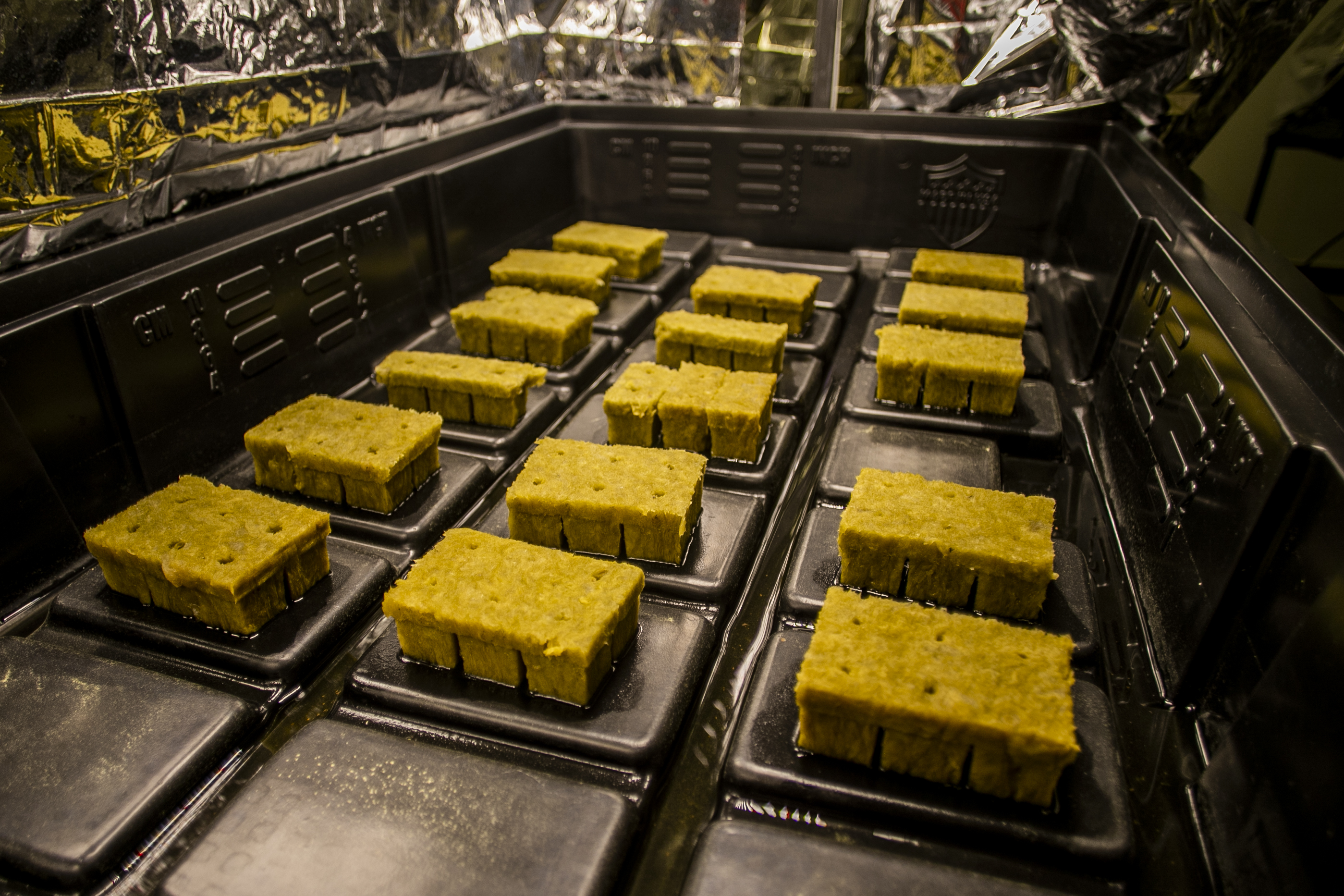
The work of C-Combinator is mostly made with Mexican sargassum, but company executives say they have the infrastructure to work with the seaweed that accumulates on the coasts of Puerto Rico.
Photo by Xavier García | Centro de Periodismo Investigativo
“You may start making your product, and then half a year later, they say, ‘Oh, now there’s a new regulation,’” she added.
Without more stability, many entrepreneurs have struggled to obtain even small grants, much less the large investments they need to scale up, according to a 2021 study led by Dr. Hazel Oxenford, a biologist at the Centre for Resource Management and Environmental Studies (CERMES) at the University of the West Indies in Barbados.
“Addressing [the sargassum] issue solely as a hazard has proven extremely costly, and attention is slowly turning towards the potential opportunities for sargassum reuse and valorization,” they wrote in the journal Phycology, dedicated to the study of algae. “However, turning the ‘sargassum crisis into gold’ is not easy.”
The researchers grouped the constraints facing sargassum entrepreneurs and researchers into five categories: an unpredictable supply; issues associated with the seaweed’s chemical composition; harvest, transport and storage; governance; and funding.
Three years later, Elmer and other researchers and entrepreneurs across the region say they still grapple with such obstacles.
Heavy metals
But despite these challenges, they continue working to find solutions. One popular early idea was using sargassum for fertilizer or animal feed. But some entrepreneurs have pulled back from this approach after research found a high content of arsenic in the seaweed and recommended against using it for nutritional purposes.
Among them was Daviean Morrison in Jamaica. Morrison first launched his company Awganic Inputs with the hope of producing organic goat feed, but he later abandoned that idea and began researching the possibility of producing charcoal, which is widely used by farmers in many rural parts of the island.
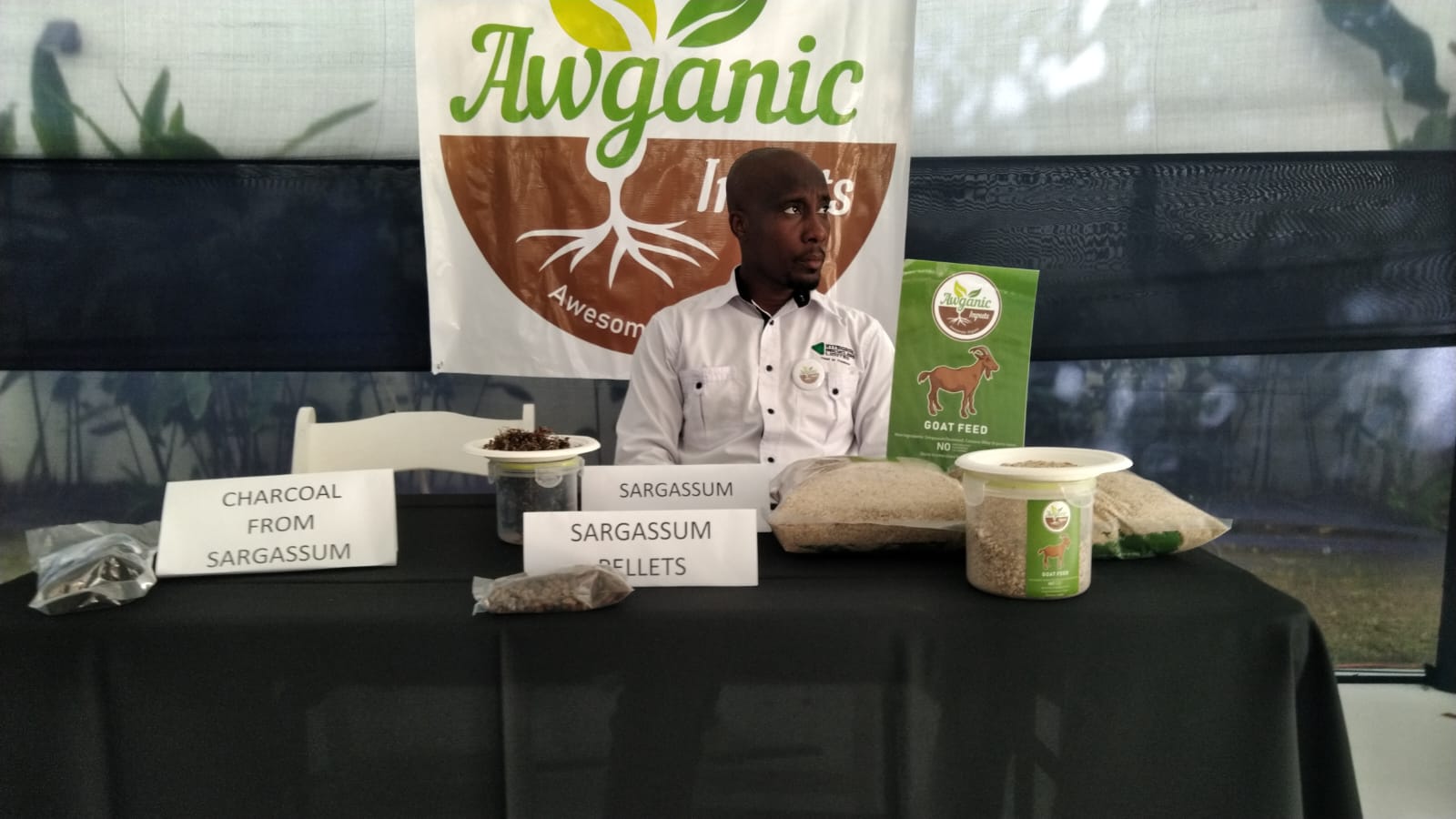
Daviean Morrison launched his company Awganic Inputs in Jamaica with the hope of producing organic goat feed with sargassum.
Photo courtesy of Awganic Inputs
But he struggled to find sufficient funding to collect enough sargassum.
“Even if we look at the collaboration with the NGO and the civic groups, who are supposed to move it for free, it’s a $15,000 [US$96]-per-trip charge for a truck, and the most we remove there is about three tons,” he said.
After the Covid-19 outbreak slowed the charcoal business — and 2023 brought less sargassum than 2022 to Jamaica — Morrison put the plan on hold.
He now operates a wireless internet business in rural communities, saving his profits to fund the anticipated relaunch of his charcoal endeavours when funding allows.
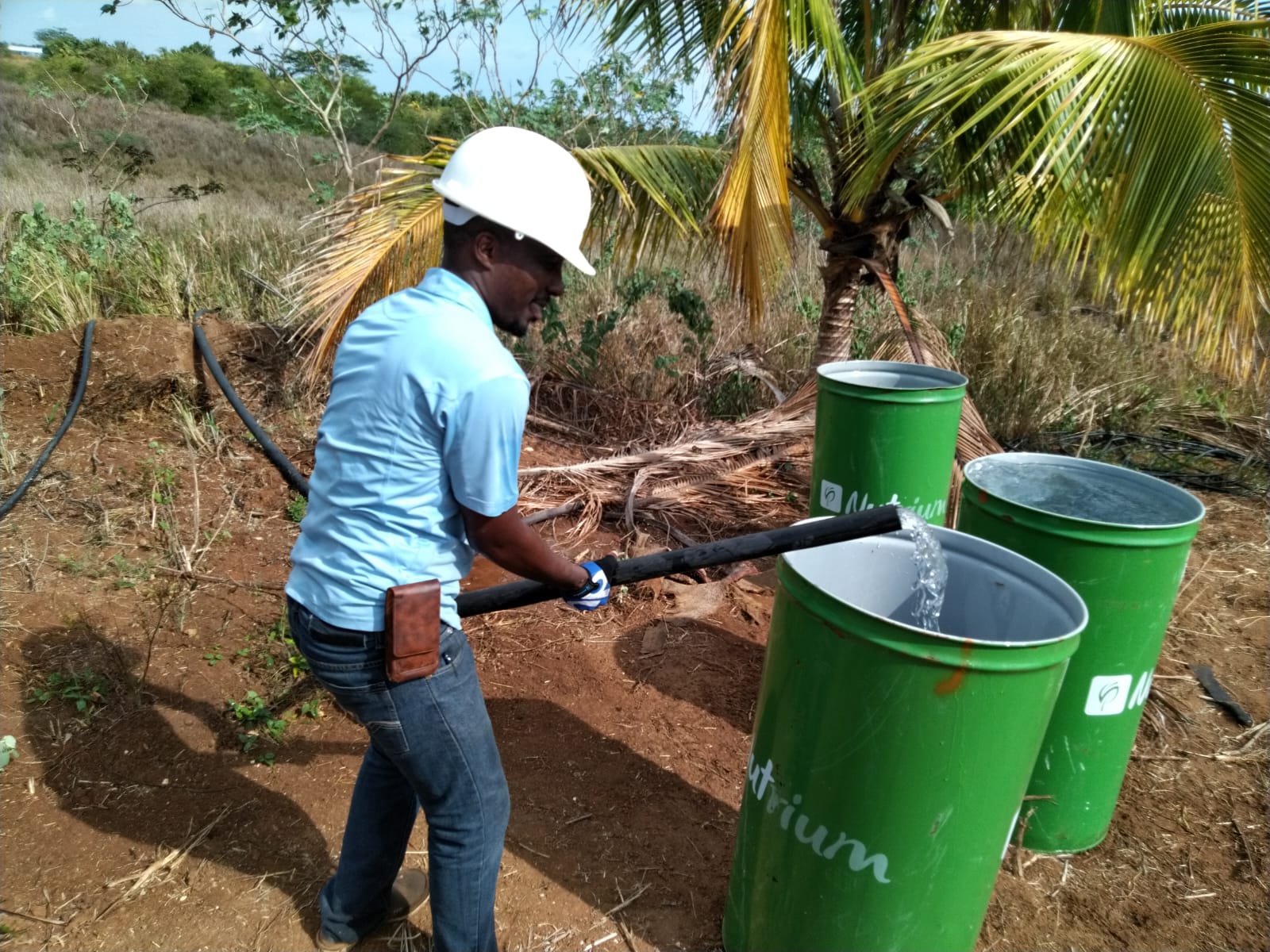
Daveian Morrison filling up water drums for his first prototype sargassum goat feed mill project.
Photo courtesy of Awganic Inputs
Related research efforts in Jamaica have run into similar problems.
Contracted by the government in 2018, the University of the West Indies’ Natural Products Institute (NPI) probed sargassum’s potential in biofuel and food additives, as well as carrying out “very preliminary assessments of the effect of sargassum extracts on [prostate and breast] cancer cells,” according to Webber, who is also the director of the university’s Centre for Marine Sciences.
But the effort proved costly, and investors were hard to find, Webber said.
Ultimately, the work stalled after the discovery of arsenic and other harmful chemicals in sargassum, according to the scientist.
Currently, she explained, scientists do not have any feasible method of extracting such chemicals, though the UWI team hopes to obtain funding for the purpose in the future.
“No one at UWI is currently doing research on uses of sargassum,” Webber added.
Capturing carbon
Eventually, product creators in need of a consistent sargassum supply may get a helping hand from Seafields.
The UK-headquartered company — which also has research operations in Mexico and St. Vincent and the Grenadines — hopes to create a series of sargassum farms in the southern Atlantic Ocean with a total area about the size of Portugal. After extracting nutrients and other useful elements from the seaweed collected at the farms, the company would bale and sink the rest in order to capture carbon and sell credits on the carbon market.
Backed by investors and a $310,000 grant from Innovate UK, the company hopes the system would also help ensure a consistent supply of the seaweed year-round.
But the venture is not easy, according to Elmer, who is currently based in Mexico. Though Seafields hopes to expand its collection system to other islands, she noted a lack of data on sargassum blooms in different areas.
“If you don’t have the data, you first have to spend several months or a season to actually monitor and look at the place before you can make really big investments,” she said.
The nature of the seaweed itself also presents challenges, according to the marine biologist.
“The main one is that the sargassum has to be quite fresh,” she said. “A lot of sargassum arrives on the beach. You may not be able to use it all or even pick it all up until it gets rotten and starts to decompose. The other hurdle is that you never know how much you get each day. Like, it’s up and down.”
A lack of consistent legislation and policy coordination across the region raises other obstacles, she said.
A Caribbean-wide regulatory framework, she added, would help entrepreneurs scale up their products. “Because then if you start a solution, you could bring it to other islands,” she said.
Mexico, brick by brick
In Mexico, Omar Vázquez Sanchez has been turning heads since 2018, when he created bricks out of sargassum.
He markets his Sargablocks as a housing solution, particularly for poor families. Vazquez Sanchez explained that the project was born out of desperation, after he lost a three-month government contract to clear sargassum from the beach. He drew on childhood memories of his grandparents’ adobe house and decided to make his own.

Since 2018, Omar Vázquez Sanchez has been creating sargassum-based building blocks in Mexico where he created the company Sargabloks.
Photo by Bris Landaverde | Sargabloks
Vazquez Sanchez said he started selling Sargablocks last year. Although he declined to disclose his profits, he said he has been earning enough to pay his bills and support nine employees.
“With Sargablock, they have probably built about 40 or 50 houses,” he said.
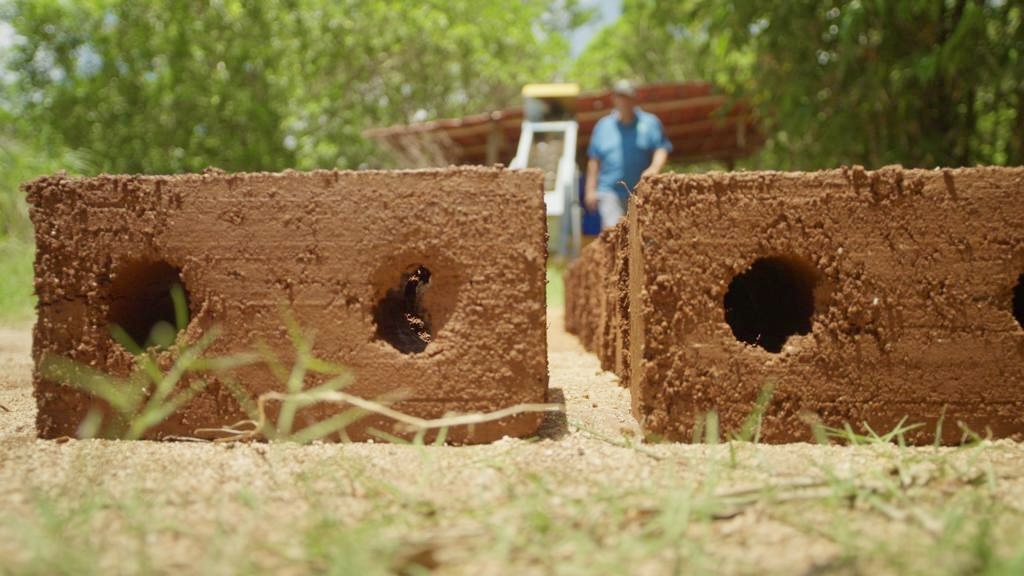
The blocks that Sargablok manufactures with sargassum seek to help in the construction of homes for families with limited resources in Mexico.
Photo by Bris Landaverde | Sargabloks
However, he has struggled to scale up without support from the Mexican government or private partners, who he said are reluctant to invest in part because of his insistence on donating three percent of profits to charity.
“If it had been invented in Germany, trust me, all the Mexicans would … be building with Sargablock,” he said. “But it’s a Mexican product.”
Now, he is looking abroad. He hopes to franchise his business and create partnerships with interested countries, opening a Sargablock factory in Colombia and securing deals with Belize and Dominican Republic before moving forward to Guadeloupe, Martinique and Puerto Rico, he said.
But in order to expand in this manner, he must purchase larger machinery that can make at least double the 2,000 bricks per day he said he is currently able to produce.
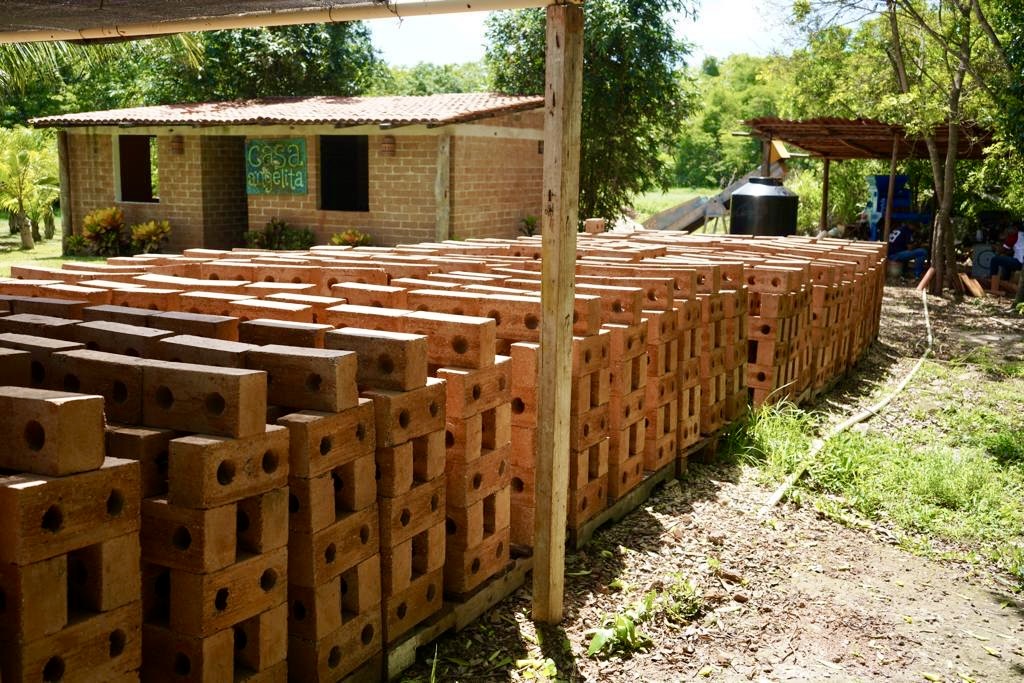
According to Omar Vázquez Sanchez, the intention of Sargablock is to distribute it to countries such as Colombia, Belize, Dominican Republic, Guadeloupe, Martinique and Puerto Rico.
Photo by Bris Landaverde | Sargabloks
Rum and Sargassum
In Barbados, researchers at the University of the West Indies are working to develop biofuel using sargassum and the waste water from rum distilleries.
She, too, is seeking funding.
“This is a new fuel that we’re putting in old technology to get fossil-free transport, and so it’ll take some investment to get to the point of customers actually buying from us,” Henry said in a video posted last June by CERMES.
She hopes to have methane-powered vehicles on the streets of Barbados by January 2026.
“Until then, we’re setting up this sort of demonstration gas station, which we’ll use to continue to gather data to understand the solution, but we’re very sure that it works,” she said. She noted that the student researchers went into this experiment with only stipends from the Inter-American Development Bank, and once they started to see results from the biogas tests, the IDB requested a technical paper on their findings, which was published in April 2021.
Also in Barbados, entrepreneur Joshua Forte has worked with the UWI Cave Hill Campus to create a plant supplement using sargassum.
Now, he sells the product through his company Red Diamond Compost Incorporated, and said it performs better than a popular synthetic fertilizer he tested it against.
“Even by cutting the synthetic fertilizer by half and adding our super seaweed bio-stimulant to it, it still had even greater results,” he said.
When he started the project about eight years ago, he said, he felt like “the only person out there looking to do something” with the seaweed. Today, he has plenty of competition, and he has not yet been able to find investment to expand into bio-fungicide production as he had initially planned.
But he has high hopes for the future.
Looks good on paper
Other sargassum solutions range widely.
At the National University of Colombia in Bogotá, marine biologist Briggite Gavio and her student Diego Aguilera have been using the seaweed to make paper.
The effort is part of a larger project on risk reduction and economic alternatives in the Colombian archipelago of San Andrés, Providencia and Santa Catalina.
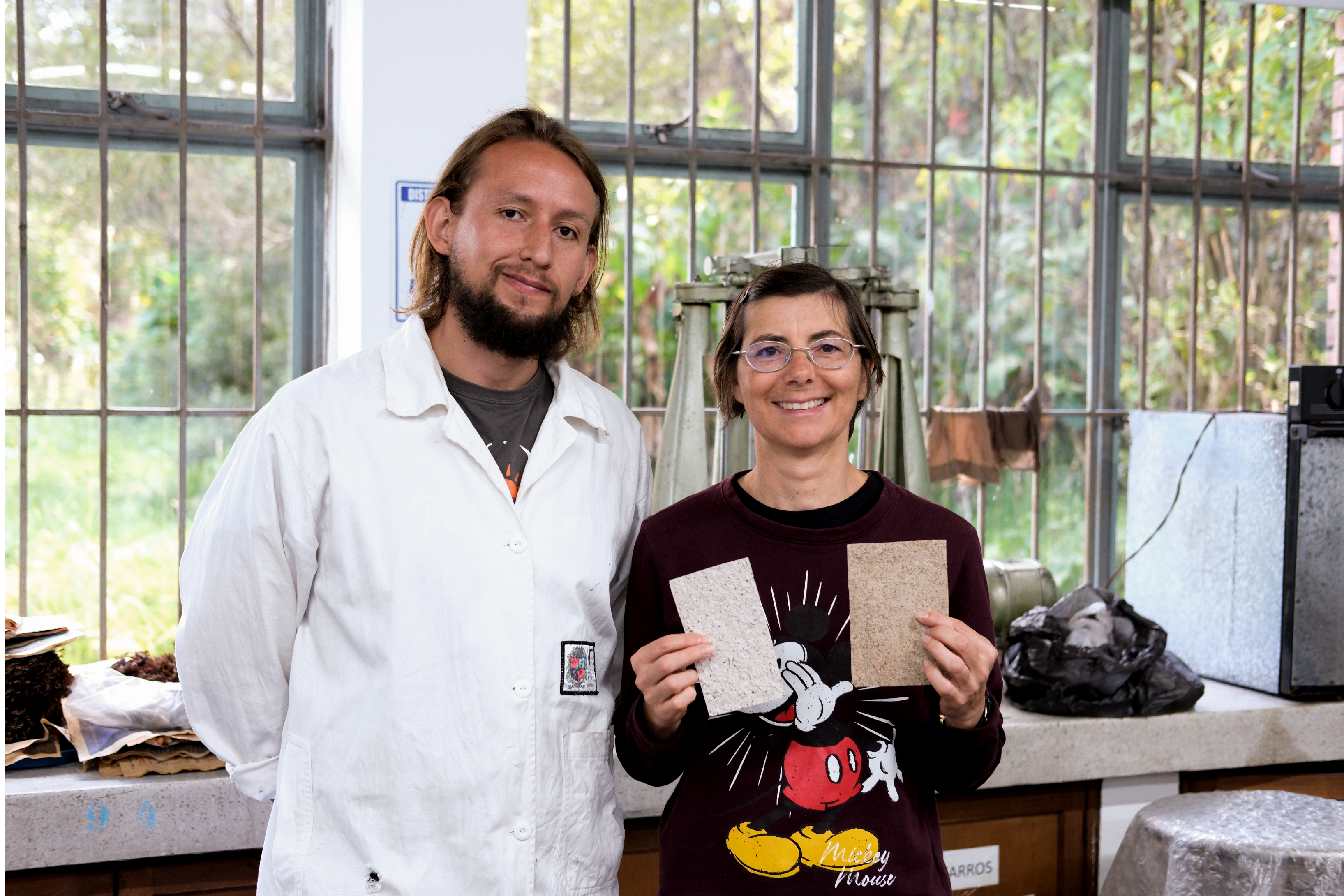
Universidad Nacional de Colombia professor Briggite Gavio, together with student Diego Aguilera. Both are working to generate paper from sargassum.
Photo by Camila Alzate | El País
The paper-making process is labour intensive. Once a collection permit is obtained, Gavio removes the seaweed by hand from beaches on the island of San Andrés. Sand is then sifted out before the algae is sun-dried and transported to Bogotá in coolers. There, it is washed, dried, ground and mixed with coconut husks, water and other ingredients.
After this mixture is chemically processed, it is pressed and left to dry for about a week. Currently, the research team is working on refining the process in hopes of producing a better quality paper.
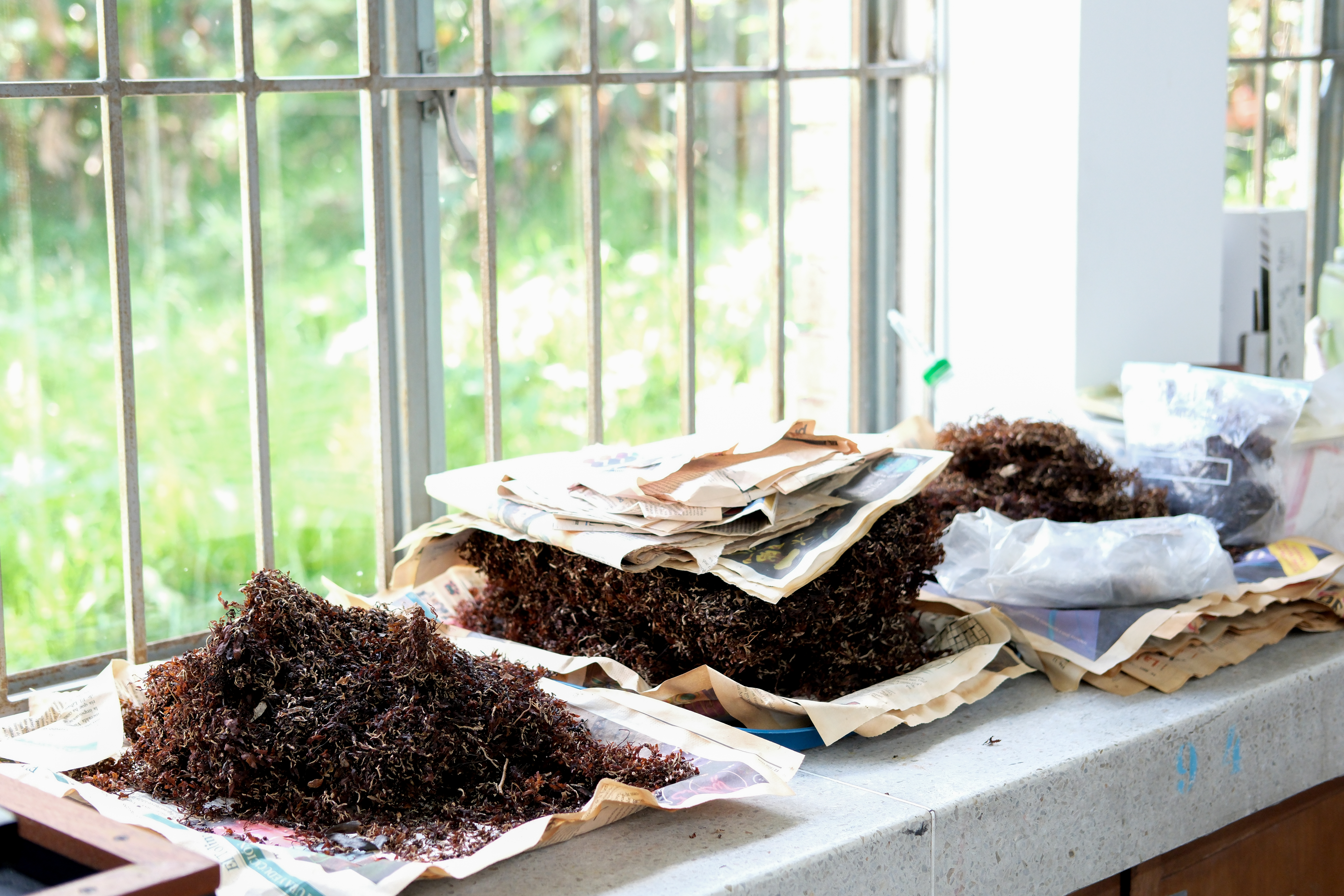
This is how sargassum, brought from San Andres, is dried to become raw material for paper.
Photo by Camila Alzate | El País
But there are many challenges. Last year, for instance, a large sargassum influx predicted early in the year never came.
“Precisely when I need sargassum is when it doesn’t arrive,” Gavio said. Nevertheless, she hopes that their efforts will eventually provide the islands with sustainable solutions to a major problem that has threatened their tourism industry and other aspects of life.
“The only one working on it is me,” she said, adding, “Right now, the treatment when it arrives is to dump it in a landfill, but it is not a long-term solution.”
Solutions
The Oxenford study offered dozens of recommendation for lifting the obstacles blocking sargassum entrepreneurs: improving forecasting systems; using government subsidies to facilitate marketing; improving harvesting and transportation systems; developing safety standards; devising better storage methods and other ways to ensure a steady supply; encouraging “sargassum industrial parks,” and many others.
But none of these steps, the researchers noted, will work if taken in isolation.
“It is recommended that the solutions and actions proposed are integrated into a regional strategy and action plan that promotes valorization as an economic opportunity and as a means of alleviating influx impacts,” they wrote.
Otherwise, the researchers predicted a bleak future.
“The evidence suggests that although efforts to explore opportunities in the Caribbean are well underway, sargassum influxes will remain more of a hazard than a benefit unless current constraints are adequately addressed,” they stated.


